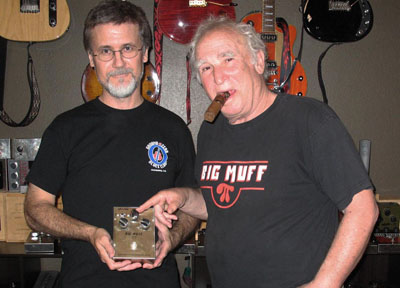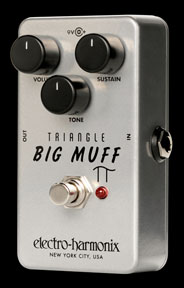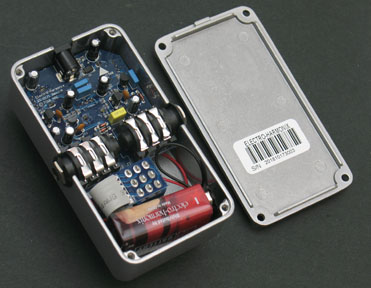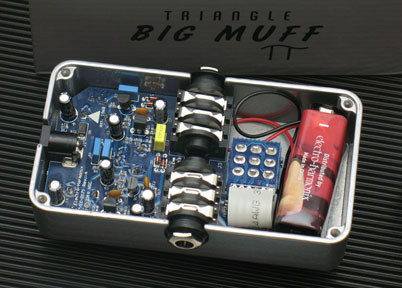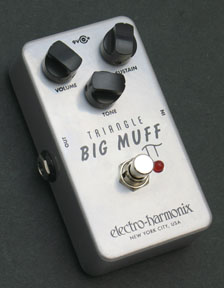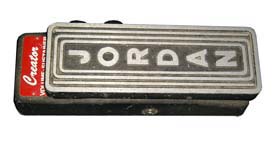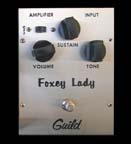THE BIG MUFF π - A HISTORY OF ALL VERSIONS - Part 1
Click on any Big Muff in the image below to go directly to that section
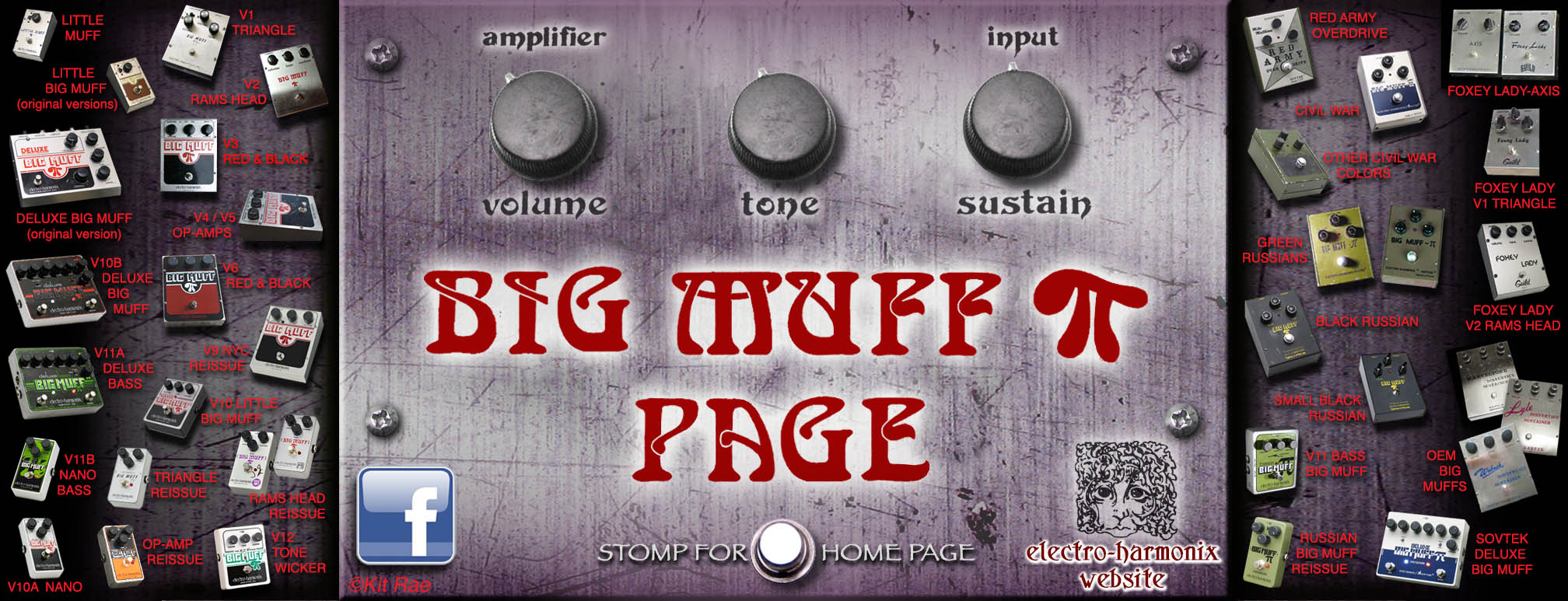
NOTE: Last update December 2018. This website is constantly updated as new information becomes available. Version, Edition, and Revision numbers listed here are not actual Electro-Harmonix identifiers. They are my categorizations, for identification purposes only. Permission required to repost any information from this site in any ebay listing. Website and contents ©Kit Rae.
THE LEGENDARY SANTANA TRIANGLE BIG MUFF - Alhough often associated with the Big Muff in Electro-Harmonix advertising, it is unknown if guitarist Carlos Santana ever actually recorded with one. Santana's well known, super-sustained and smooth distortion tone on his early records reportedly came from an early P-90 or humbucker equipped Les Paul played into a Fender Twin Reverb at high volume. He also later used a Randall Smith modded tweed Fender Bassman amp mounted inside a Fender Princeton cab with a 12" speaker, nicknamed the "Princeton Boogie". Smith made around 100 of these modded Fenders, and eventually developed this mod into the Mesa Boogie Mark I amps Santana later became associated with. Santana also used other amps in the late 60's and early 70's, even solid state amps. His tone came from these clean amps, high volume, and natural speaker compression and sustain.
Shown above - a reciept and check from Carlos Santana for the V1 Big Muff he purchased in '71 (thanks to Mike Matthews for the scan), and the Santana III album cover art
It is documented that Santana purchased a V1 Triangle Big Muff in February 1971. It was possibly used on the Santana (aka Santana III) album released later in 1971. Santana may have also used a Big Muff on some tracks from Abraxas, his previous album, recorded in 1970. Several of those solos sound exactly like a Big Muff through a Fender amp. Using a P-90 equipped Les Paul set to the middle position, an early triangle Big Muff (sustain set about 30%, tone about 50%), and a clean Fender Twin Reverb at high volume (just to the point of feedback) you can recreate nearly the exact tone heard in Santana's cover of Black Magic Woman. A similar tone can also be created by turning the Twin volume all the way up until the sound starts to break a little, but that is deafening, and does not sound as close as using the Big Muff in my opionion. Until Santana ever speaks of or documents using a Big Muff, we will never know, but what is known as the Santana signature tone from throughout his later career is certainly not a Big Muff pedal. The only pedal Santana has consistantly used is a wah pedal.
PINK FLOYD / DAVID GILMOUR TRIANGLE BIG MUFF - Although it is unknown if guitarist David Gilmour ever used a Triangle Big Muff for any Pink Floyd recordings, a Triangle BMP was seen on top of his Pete Cornish-made, all-tube board in 2006 On and Island rehearsal and on later dates of the tour. One has also been seen on a testing pedal board in 2011 and a pedal board in his Medina studio in 2017. Gilmour's primary Big Muff was the V2 Ram's Head version. You can read about Gilmour's various Big Muffs here.


Shown above - David Gilmour's 2006 tour pedal board with Triangle Big Muff on top, and a testing pedal board in 2011

Shown above - A Ram's Head Big Muff and Triangle Big Muff from David's Medina studio in 2017
THE TRIANGLE BIG MUFF π REISSUE
Released September 2018
Reissue Engineer: Gino Maisano, based on Bob Myer's original design
PCB Number: EC-D171 REV A
True Bypass: Yes
Power Supply: 9-Volt battery or optional 9V power supply from Electro-Harmonix, 9.6DC-200BI (same as used by Boss™ & Ibanez™) 9.6 Volts DC, or other AC adapters capable of delivering at least 30mA.
Current Draw: Approx 2.2 mA
Packaging: silver and black corrugated box
Place of Manufacture: Assembled and tested in Long Island City, New York, USA

Your original pi. In October 2018 Electro-Harmonix continued with their line of nano sized Big Muff reissues (following the Green Russian and Op-Amp) and released the Triangle Big Muff. It was the perfect time to release this reissue, as 2018 was the 50th anniversary of the founding of Electro-Harmonix. If any pedal could be said to be the flagship of that company, it was the Big Muff Pi. As the promotional copy stated, it was "A re-creation of the original and dripping with vintage Electro-Harmonix DNA and tone. Dubbed the Triangle Big Muff because of the layout of its Volume, Sustain and Tone controls, this is the one that started it all circa 1969." There were many circuit variants inside the V1 Big Muffs, and a wide variety of different sounds among them. It's impossible to make 'one' reissue that sounds like all of them (although the Deluxe Big Muff almost does!), but EHX successfully captured the sound of a few of the more common V1 circuit variants with the reissue. In so doing, EHX recaptured a key piece of their heritage from the clone builders, and at a price that is difficult to compete with.
This was technically the 5th reissue of the Big Muff, although many people seem unaware of that fact. The original Electro-Harmonix company based in New York went out of business in 1984. When New Sensor resurrected EHX under the Sovtek brand in the 1990s the first pedal reissued was a Big Muff. Then in 2000 EHX reissued it again in the same type of enclosure as the last NYC version from 1984. In 2017 the "Green Russian" version of the Sovtek Big Muff was reissued, then the Op-Amp and Triangle reissues followed in 2018.
DEVELOPMENT - The very early 1969-1970 Big Muffs with the perf board circuits have always been EHX owner Mike Matthews' favorites, so the reissue research started with those. Electro-Harmonix has always been focused on new and innovative ideas. As such, they have not dwelled in the past or kept examples of every vintage version of the Big Muff, especially the very rare perfboard Triangle Big Muffs. EHX relies on friends and collectors to loan them vintage units to examine and dissect. In 2015 Mike came by my little studio to test three originals from my collection. Mike is a keyboardist, not a guitarist, but he can fret and pick strings. He would pick a note and listen to the sound and how it sustained. There was a specific sound that he remembered and he almost immediately picked out the one that had it. Testing went on for some time among the three, but Mike kept going back to that specific V1.
Shown above - Kit Rae and Mike Matthews checking out some very early Triangle Big Muffs in 2015
The perfboard V1 Mike liked was a very rare circuit varaint with some unique differences not found on any other V1s that followed. EHX also had another rare vintage V1 from around 1970 that was used for research and development. It was also an early unit, and probably the first circuit variant that was ever made on a printed circuit board (PCB). This PCB had the first version of the circuit trace, which required a jumper wire to be soldered on the trace side of the board. The trace was later updated to eliminate the need for the jumper sometime in 1970, so all later V1s used a revised PCB.

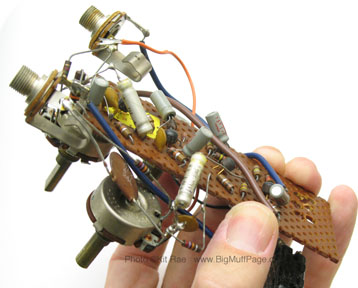
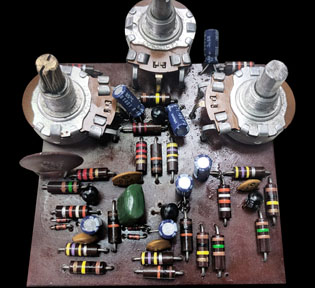
Shown above - The two primary Triangle Big Muff circuits used for research and development of the reissue. The one on the left is an early circuit soldered on perforated
board with some off-board point-to-point wiring.
Perfboard is usually used for prototyping electronic circuits,
but the very early V1 Big Muffs were hand-made this way.
The one on the right was from later production after the change to a printed citcuit board (PCB), and was probably the first V1 circuit variant ever made on a PCB.
Electro-Harmonix engineer Gino Maisano was responsible for developing the reissue circuit. Gino was also responsible for the Green Russian and Op-Amp Big Muff reissues. Much research went into the final circuit, including examining schematics of the other V1 circuit variants and dissecting and measuring the two vintage originals. The final reissue was a blend of component values from both, successfully replicating the sound of a few of the more common V1 circuit variants. It is one thing to get a modern circuit to sound similar to an original, but it is another to make it "feel" the same and capture the same type of vibe when actually playing it, and hear and feel what is different about it compared to the other Big Muffs in the EHX line. It is something that is difficult to get across with demo videos. Here is what EHX engineer Gino Maisano had to say on the subject -
"Videos are a huge help...especially the one showing all the different Triangle variants. People will understand that there isn’t a singular one but hopefully the reissue captures the overall vibe. The real problem with comparison videos, especially with Big Muffs, is that the user doesn’t get to feel the differences, and I think that’s the biggest thing with the Big Muff variants. Yes, side-by-side the Green Russian, Op-Amp, and Triangle will certainly sound different from each other in a comparison, but the truth is they all pretty much sound the same, from a macro point of view, because they’re all Big Muffs. It’s when you’re the one actually playing through them that you can feel how truly different their characteristics are. They can respond differently and drive the mood of the music differently. Highs, mids, bottom end… All of those differences are perceivable for sure, but things like tightness, airiness, crunch, response, bite, life… All of those things you have to feel for yourself. That’s the biggest message I want to get across for people to understand the differences."
GRAPHICS AND ECLOSURE - Housed in the standard EHX nano sized cast metal enclosure, 4 3/8" (L) x 1 3/8" (W) x 2 1/8"(H). The graphics layout is slightly different than the original V1s, but the Big Muff and Pi fonts are identical to the original V1 fonts. The nickname "Triangle" has been included in the graphics. The triangular layout of the knobs, which is where the nickname for this version came from, is in reverse of the original V1. The circuit board inside is marked "est. 1968", the year Electro-Harmonix was created.
CONTROLS - Standard volume, tone, and sustain controls as on the classic Big Muff.
CIRCUIT - The circuit uses through-hole style transistors, capacitors, and diodes. Resistors are small surface mount type. Transistors are BC547.
PACKAGING - 2-color corrugated cardboard box. "Your original pi" is printed on the inside box lid flap.
Shown above - The Triangle Big Muff reissue from 2018, featuring a recreation of the original logo font and pi graphic
Shown above - The Triangle Big Muff circuit. Note the "est 1968" text on the pcb, the year Electro-Harmonix was founded.
The Triangle Reissue was released in 2018, the 50th anniversary of Electro-Harmonix
Shown above - The Triangle Big Muff packaging
THE V1 REISSUE SOUND - The most difficult part of making a V1 reissue would have to be picking which circuit variant to replicate because there were so many, and many different sounds to choose from. When I compared the reissue to 6 or 7 vintage units in my collection, it sounded very different from 4 or 5 of them that had completely different circuits inside, but it sounded very similar to the rest. The V1 it sounded closest to just happens to be one of the more common 1970-71 circuit variants in my collection. It sounded almost identical to it, but slghtly brighter. Depending on what I played, sometimes I could not tell them apart. The reissue tone knob range was also basically the same as the original.
Overall it is probably the loudest and most aggressive Big Muff in the EHX nano line. Compared to the Green Russian reissue and the Nano Big Muff, the Triangle has a more high gain and brighter sound, but it can also sound very smooth when the sustain is dialed down a bit, especially when using a neck pickup. It has some hefty low end, but the bass is tight, not flabby. The mids are scooped, but it has just enough mid range to stand out in a band mix nicely. Overall EHX did a very good job of capturing the sound of the most common Triangle Big Muffs.
Below are some demos and comparsions to the other Electro-Harmonix nano Big Muffs, and comparisons to several vintage Triangle Big Muffs.
CUSTOMIZING YOUR TRIANGLE REISSUE - Do you want more vintage-styled knobs for your Triangle reissue? Get a set of #1611 PH-ABS Series Flared Phenolic knobs (shown below). They are close in shape to the old Daka-ware pinch knobs used on many of the original V1 Big Muffs. You can slightly modify them with a bit of fine sanding and polishing to make the shape more accurate, if desired. The bottom knob (top left photo) is an original Daka-ware pinch knob, which ocassionally turn up on ebay.
Customized #1611 PH-ABS Series Flared Phenolic knobs. The bottom knob (left photo) is an original Daka-ware pinch knob, which ocassionally turn up on ebay.

#1611 PH-ABS Series Flared Phenolic knobs
THE JORDAN CREATOR AND SUPA TONEBENDER BIG MUFF CLONES
THE JEN JUMBO FUZZ, SAM ASH JUMBO FUZZ, SAM ASH FUZZOLA II, and DALLAS ARBITER JUMBO FUZZ BIG MUFF CLONES
THE HOHNER TRI DIRTY BOOSTER BIG MUFF CLONE
View the page about the USA made Hohner clone of the Big Muff circuit, the Tri Dirty Booster, circa 1975.
MORE FOXEY LADYS
CONTINUE - MORE OF THE HISTORY OF THE BIG MUFF PART 1 (Vintage USA)
HISTORY OF THE BIG MUFF PART 2 (Russian)
HISTORY OF THE BIG MUFF PART 3 (modern USA)
© Kit Rae. This page is not authorized, affiliated, or associated with Electro Harmonix in any way
Website and contents ©2007 and ©2012 Kit Rae. All rights reserved. Linking to this website is allowed, but copying the text content is strictly prohibited without prior authorization. No part of this work may be reproduced, stored in a retrieval system, or transmitted in any other form, or by any means, electronic, mechanical, photocopying, recording, computer networking, or otherwise without prior permission in writing from the copyright holder(s).
Kit’s Secret Guitar, Gear, and Music Page
Guitar stuff, gear stuff, soundclips, videos, Gilmour/Pink Floyd stuff, photos and other goodies.
Contact: nasnandos @ kitrae.net (remove spaces around @ to email)
Copyright Kit Rae.
VISIT MY SWORDS, KNIVES and FANTASY ART WEBSITE www.kitrae.net







